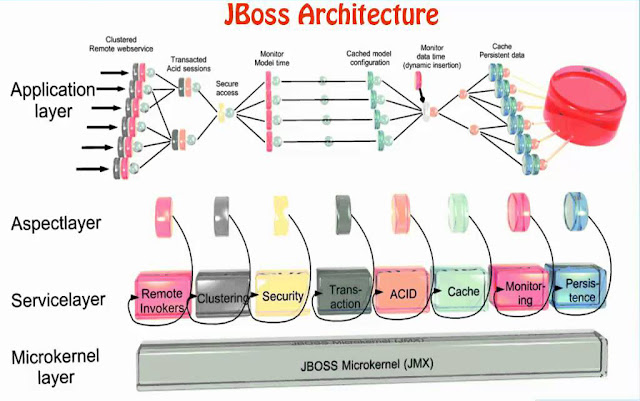JBoss administration online training for beginniers:
JBoss administration is assembled from a set of independent yet cooperating components and services that are neatly packaged and fully hot deployable. It is architected to be seamlessly embeddable in applications and the nature of its embedding is completely customizable to the requirements of the application itself. Only the critical and necessary JBoss application server training components, therefore, need to be brought along as part of the application’s baseline footprint. Developers can also easily create and add their own services to the system, thus ensuring that custom services exhibit the same consistent behavior as the JBoss standard set of services. JBoss administration is an inversion of control framework. Frameworks let you create, configure and wire up with the simple Java objects. Classes don’t need special coding to be usable. The objects created at JBoss administration usually represent the modules of your application. Service oriented architecture service is either defined as a POJO or a JMX Managed Bean, Services are hot-pluggable, Makes it possible to tune the system for just the required services to lower the overall footprint which is easier to secure and tune. Easy to define the new services and package them as SARs or JARs.
JBoss administration domain
The managed domain operating mode allows for management of multiple JBoss administration instances from a single control point. Centrally managed JBoss server collections are known as members of a domain. All JBoss administration instances in a domain share a common management policy. A domain consists of one domain controller, one or more host controller, and zero or more server groups per host. A domain controller is the central point from which the domain is controlled. It ensures that each server is configured according to the management policy of the domain. The domain controller is also a host controller. A server group is a set of server instances which have JBoss administration installed on them and are managed and configured as one. The domain controller manages the configuration of and applications deployed onto server groups. Consequently, each server in a server group shares the same configuration and deployments. It is possible for a domain controller, a single host controller, and multiple servers to run within the same JBoss administration instance, on the same physical system. Host controllers are tied to specific physical hosts. You can run multiple host controllers on the same hardware if you use different configurations, ensuring their ports and other resources do not conflict.
JBoss administration online training:
The concept of Jboss server tutorials profiles that was used in previous versions of JBoss EAP is no longer used. JBoss administration now uses a small number of configuration files to hold all information about its configuration. Modules and drivers are now loaded on an as-needed basis. Consequently the concept of a default profile used in previous versions of JBoss administration to make the server start more efficiently does not apply. At deployment time, module dependencies are determined, ordered, resolved by the server or domain controller, and loaded in the correct order. Modules are unloaded when no deployment needs them any longer. It is possible to disable modules or unload drivers and other services manually by removing the subsystems from the configuration. However, for most cases this is unnecessary. If none of your applications use a module, it will not be loaded. JBoss administration runs in one of two modes, Standalone Server or Managed Domain, and is supported on two platforms, Red Hat Enterprise Linux and Microsoft Windows Server. The specific command to start JBoss fuse training at SVR technologies depends on the underlying platform and the desired mode of JBoss administration.
Check the full video sessions :- https://www.youtube.com/playlist?list=PLUK4-WOv1eL-11CGwHNNL9QECkW530qQA







